by Margherita Guarducci
© 1960, Hawthorn Books
(all rights reserved)
| Grottoes
Vatican City Colonnade Saints Floorplan #2 |
|
|
|
|
CONTENTS
Introduction
- H. V. Morton
Preface - The Author
Illustrations
I. THE TESTIMONY OF ANCIENT AUTHORS
II. THE VATICAN IN ANCIENT TIMES
III. THE NECROPOLIS UNDER
THE BASILICA
IV. THE APOSTLES MEMORIAL
V. THE TESTIMONY OF THE
INSCRIPTIONS
VI. THE CULT OF THE APOSTLES PETER
AND PAUL ON THE APPIAN WAY
VII. CONCLUSIONS
The Author and Her Book
V.
THE TESTIMONY OF THE INSCRIPTIONS
(Page 3)
The few examples already introduced are sufficient to give an idea of the spiritual richness on the inscribed surface of Wall G.
I have mentioned the fact that among the other graffiti there are some alluding to the Emperor Constantine and to his victory of Maxentius which marks, in the history of the Church, the beginning of peace after a long period of persecution and struggles. There are two of these inscriptions, the first carved in the upper left corner of the wall, the second about halfway up the wall near the right end.
The
first of these graffiti is to the right of the ![]() preceding the name of the deceased Leonia, and it was undoubtedly
written with reference to that sign. The inscription reads: HOV VIN(CE)
(Plates IV, IX.)
preceding the name of the deceased Leonia, and it was undoubtedly
written with reference to that sign. The inscription reads: HOV VIN(CE)
(Plates IV, IX.)
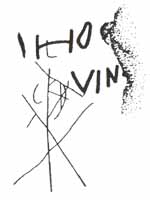
The expression hoc vince ("with this, conquer") next to the sign of the Redeemer can only be a reference to the famous vision of Constantine on the eve of the battle with Maxentius near the Milvian Bridge, October 28, 312. Some years after the battle, at least later than 325, Eusebius, Bishop of Caesarea in Palestine, heard the story of this memorable event from the lips of Constantine himself. He refers to it in his Life of Constantine,9 and states that the Emperor swore he was telling the whole truth and nothing but the truth.
This is what Eusebius wrote: "He said that with his own eyes, during the afternoon, while the day was already fading, he had seen a shining Cross in the sky, more brilliant than the sun, accompanied by the works: 'with this, conquer.' He remained stunned by the vision, and so did all the army following him in the expedition, which had also seen the miracle." During the night of this same day, Constantine said he saw Christ Himself in a dream, bearing the same sign of salvation that had already appeared brilliantly in the sky. Eusebius does not specify that the expedition during which the miracle occurred was the one by the Milvian Bridge. But confirmation of this fact comes to us from the works of a contemporary Roman writer, Lactantius, in a brief work about the deaths of persecutors (De mortibus persecutorum). Lactantius does not mention the heavenly vision and the phrase hoc vince, but he does tell of the apparition of Christ to the Emperor in a dream and states explicitly that Constantine was then near the Milvian Bridge, on the eve of the battle with Maxentius.10
Eusebius' story of the vision, with the "sign of the Cross" accompanied by the words "with this, conquer" has been questioned by some scholars, who described it as either an invention by Eusebius or a passage added to his work in later times. There was even a theory that denied Eusebius' authorship of the Life of Constantine, stating that this work must be at least a century later than the time of the Bishop of Caesarea.
Now
the graffito on Wall G has demonstrated the poor foundation of these doubts.
Since it is, as I have said, certainly earlier than the construction of
Constantine's monument in honor of St. Peter, i.e., about 315 A.D., the
conclusion must be that the story of the miracle and the prophetic phrase
were already known, at least in Rome, quite a few years before Eusebius
wrote the biography of Constantine. It is also significant that the expression
hoc vince was found on Wall G next to the ![]() .
This immediate proximity indicates that the miraculous sign mentioned
by Eusebius must have been the
.
This immediate proximity indicates that the miraculous sign mentioned
by Eusebius must have been the ![]() and not the common sign of the Latin Cross, as some have assumed.
and not the common sign of the Latin Cross, as some have assumed.
Everyone is free to believe or not to believe in the historic truth of Constantine's vision. But the testimony of our graffito remains beyond discussion: the news of the miracle must have been widely known in Rome by about 315 A.D., and the miraculous sign in the case must have been the . The date is almost immediately after the battle by the Milvian Bridge, and it is worth noting that a fresh, living echo of the event, even the very expression which the Emperor saw glowing in the sky as a divine prediction of his victory and of the future triumph of the Church, resounds at the heart of the Vatican basilica, directly under the papal altar.
The other graffito which refers to Constantine is particularly interesting because it links a mention of Peter's tomb with mention of the Emperor.
The basic inscription which gave origin to this graffito is very simple and presents a fairly common formula. It is a wish that two dead persons, Victor and Gaudentia, may live in Christ: VICTOR GAVDENTIA VIVATIS IN . (Plates VII, VIII.)

Under this graffito, another hand later wrote - or had previously written - the expression W I A (Plates VII, VIII, XII.)

signifying, as I have already observed, vivas (or vivatis) i(n) A, that is "may you (singular or plural) live in the Life (which means, in Christ)." If the expression was written at a later date, it probably refers to Victor and Gaudentia; if it was written earlier it must be considered an "anonymous" wish, applied to deceased Christians in general and particularly to those in the Vatican necropolis. Be that as it may, the epigraph of Victor and Gaudentia already existed when someone decided to use the W I A as a basis for still another wish referring to these two. For this purpose, the second V of the W was heavily rewritten and a vertical line (serving as the letter I) was inserted after the VIVATI of the epigraph of Victor and Gaudentia, arranged in such a way as to indicate a transition to the VIA on the line below. After the VIA, the word SPECI was added. (Plates VI, VIII, XII, XIII.)
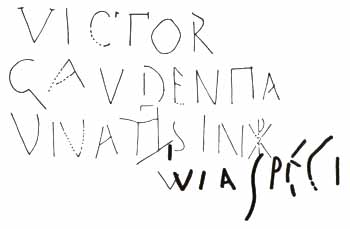
This made it possible to read two phrases simultaneously:
VIVATIS
IN ![]()
VIVATI I VIA SPECI
i.e., "may you live in Christ" and "may you live on the road of the crypt."
In the
second phrase, the VIVATI is clearly equivalent to VIVATIS, and the I
can be interpreted as IN, recalling the practice, introduced in the late
Latin, of dropping final consonants. The word SPECI, which is quite legible,
can only be explained as the genitive singular of specus. True,
specus is a fourth declension noun and we would expect the genitive
to be specus, not speci; but the irregularity is only apparent
since the Romans - particularly during the Imperial age - frequently confused
the cases of the various declensions and often gave the endings of the
second to nouns of the fourth. Speci is, then, the genitive of
specus, a Latin word used to indicate a natural or artificial cave.
In the language of the Christians it could mean (as various examples show)
the place set apart to preserve the remains of a martyr, in other words,
a crypt. And this is precisely the meaning we must give the word speci
on Wall G. But a crypt, mentioned without any other specification in this
place, could only have one meaning; the crypt of Peter, the underground
grave in which according to the firm belief of the faithful, the remains
of the Apostle rested. It is very significant that, during the same period,
Christ's tomb in Jerusalem was also called specus (or spelunca)
and, in Greek, ![]() (antron-cave). Even in this usage, Peter had something in common
with his divine Master.
(antron-cave). Even in this usage, Peter had something in common
with his divine Master.
As for
the double wish: vivatis in ![]() and vivati(s) i(n) via speci, its meaning is easy to understand.
Assuming that the tombs of Victor and Gaudentia were in
the Vatican necropolis and precisely on the road which led to Peter's
crypt, it is easy to understand that, in wishing the two souls life in
Christ it was also found worthwhile to record the proximity of their tombs
to that of the Martyr: a privilege which, in the common belief of Christians
at that time, was a guarantee of eternal salvation.
and vivati(s) i(n) via speci, its meaning is easy to understand.
Assuming that the tombs of Victor and Gaudentia were in
the Vatican necropolis and precisely on the road which led to Peter's
crypt, it is easy to understand that, in wishing the two souls life in
Christ it was also found worthwhile to record the proximity of their tombs
to that of the Martyr: a privilege which, in the common belief of Christians
at that time, was a guarantee of eternal salvation.
The record of Constantine's victory was grafted onto the expression in via speci by the addition of the new and very significant word, VLTI, before SPECI (Plates VII, VIII, XII.)

The expression ulti speci ("of the avenged crypt") seems obscure, but it quickly becomes clear when we consider that Constantine claimed the glory of having "avenged" Rome for the injuries suffered through the tyrant Maxentius. We are told this, for instance, in the official inscription on the Arch of Triumph which the Romans dedicated to the Emperor in 315 in memory of his victory near the Milvian Bridge: iustis rem publicam ultus est armis ("he avenged the state with just arms.")11 The panegyrist Nazarius used the same verb ulciscor (ulcisco) in the discourse prepared by him for the same happy occasion.12 At the end of the century, the Christian poet Prudentius exalted the "avenger" (ultor) Constantine and his "avenging" (ultrix) army, who had crossed the Alps to free Rome from the tyranny of Maxentius.13
Since the deeds of Constantine were interpreted by him contemporaries under the heading of revenge, we are able to understand the expression on our graffito: ulti speci. Evidently the meaning was that, just as Rome had been avenged, the Apostle's crypt, now considered a protector and practically a symbol of the City, was also vindicated.
The few graffiti examined have clearly shown that the Wall G inscriptions were not written haphazardly and without plan by occasional visitors. They are, rather, a complex embroidery of signs, traced for a clearly seen purpose, by people with an exact knowledge of the previously written graffiti. There was plainly an intention of respecting the earlier graffiti and, wherever possible, of using them to enrich the precious wall with new mystical values. This leads us to believe that not everyone had free access to this place, but only a few privileged custodians who were given the task of representing the faithful and inscribing the wall for them. Therefore we must presume that the venerated place was closed off to protect it from the sometimes excessive manifestations of popular piety. This sort of thing still happens in our own time at very popular shrines: the crowd stays outside a railing and the sacristans receive the offerings of the faithful and light candles for them before the altar, holy image, or object of special veneration.
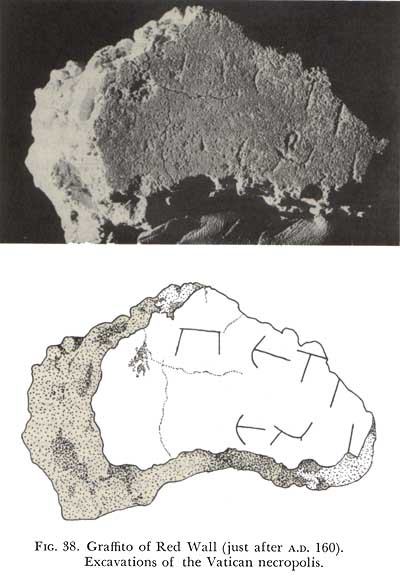 The
inscriptions on Wall G are distinguished by a deep spirituality. The thoughts
of those who wrote them, animated with faith in Christian truths and hope
for an eternal reward, were constantly fixed on the things of heaven.
On this point, our graffiti differ radically from others found elsewhere
in ancient Christian Rome and, in particular, from those under the church
of St. Sebastian on the Appian Way, a place devoted to the cult of the
Apostles Peter and Paul.14 This deep spirituality is a new
and sure indication of the importance attributed by the faithful to the
Apostolic Memorial in the Vaticano. Since a fervent cult could not have
risen up in a few months or even in a few years, we must conclude that
it has its roots in a much earlier time.
The
inscriptions on Wall G are distinguished by a deep spirituality. The thoughts
of those who wrote them, animated with faith in Christian truths and hope
for an eternal reward, were constantly fixed on the things of heaven.
On this point, our graffiti differ radically from others found elsewhere
in ancient Christian Rome and, in particular, from those under the church
of St. Sebastian on the Appian Way, a place devoted to the cult of the
Apostles Peter and Paul.14 This deep spirituality is a new
and sure indication of the importance attributed by the faithful to the
Apostolic Memorial in the Vaticano. Since a fervent cult could not have
risen up in a few months or even in a few years, we must conclude that
it has its roots in a much earlier time.
Among the insistent aspirations to heavenly things (light, peace, salvation, Paradise, victory, life) which dominate the surface of Wall G, the figures of Christ, Peter and Mary stand out. Christ is presented as God and Son of God, participant in the Trinity, often united with the idea of the Cross and always considered as the Being in whom all Christian is mystically summed up. Peter is often associated with Christ, and this graphic association of the two names is so close that the Apostle is considered almost one with the Redeemer.
Master and Disciple are quite often united in a single acclamation of victory. Similarly, the names of Christ and Mary are often associated, while in other cases (one of which we have examined)15 the names of Christ, Mary and Peter are placed together and the victory of this heavenly trio is acclaimed as a motif for the encouragement of the faithful.
Summing up, we can say that Wall G contains, in synthesis, a true and proper treatise on theology; together with the memory of Peter and with historic allusions to the battle by the Milvian Bridge, it might be said to contain all the most sacred and cherished ideas of the faithful. Its location gives this treatise a particular importance, and in one sense it might almost be considered the foundation stone of the greatest Christian basilica.
B. The Graffiti on the Red Wall
From the numerous graffiti on Wall G, we shall now pass on to the few but no less important writings preserved on the Red Wall. These are found in a small fragment of the red plaster which once covered the wall, precisely at the place where Wall G meets the Red Wall; just above the repository which, as I have mentioned, is contained in Wall G.16 There are two small graffiti, one of which has remained in its original place while the other, removed during the first excavations, is now kept in the offices of the Fabbrica di San Pietro (Building of St. Peter).
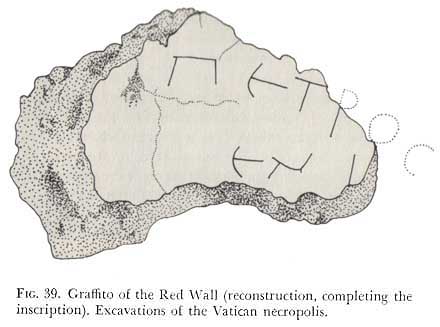 Since
the Red Wall was built around 160 A.D. (a point which we establish from
the examination of a series of bricks with the manufacturers' seals on
them)17 and Wall G can be dated, through various archaeological
and topographical data, around 250 A.D., the age of the graffiti on the
Red Wall must naturally be between those two dates. One of the graffiti
seems very close to the earlier date and must be considered, at least,
earlier than the end of the second century.
Since
the Red Wall was built around 160 A.D. (a point which we establish from
the examination of a series of bricks with the manufacturers' seals on
them)17 and Wall G can be dated, through various archaeological
and topographical data, around 250 A.D., the age of the graffiti on the
Red Wall must naturally be between those two dates. One of the graffiti
seems very close to the earlier date and must be considered, at least,
earlier than the end of the second century.
This graffito is Greek and it is placed on two lines. There are four letters on the first line and three on the second, not very deeply carved and averaging about 0.7 centimeters in height. To the left of the inscription, the surface of the plaster shows no traces of writing; but to the right the epigraph must have continued, at least on the first line (Fig. 39).
On the
first line, it is easy to recognize the beginning of Peter's name in Greek
( ![]() ). In this location, the name must naturally refer to the Apostle. This
has been admitted by virtual unanimity by the scholars who have studied
the graffito. On the contrary, the three letters on the second line have
been interpreted in widely varying ways. Some have erroneously given importance
to a slight irregularity in the plaster to the left of a vertical line,
which led them to believe that the final letter of the graffito is a delta.
Actually, it is a simple vertical line which clearly forms an iota.
). In this location, the name must naturally refer to the Apostle. This
has been admitted by virtual unanimity by the scholars who have studied
the graffito. On the contrary, the three letters on the second line have
been interpreted in widely varying ways. Some have erroneously given importance
to a slight irregularity in the plaster to the left of a vertical line,
which led them to believe that the final letter of the graffito is a delta.
Actually, it is a simple vertical line which clearly forms an iota.
To understand
the graffito in its true significance, we must bear in mind that the first
line slopes downward, as though the writer of the epigraph, finding himself
in an awkward position, had used his elbow as a pivot. If we follow the
broken-off line along its indicated path, it becomes evident that after
two more letters it is necessary to stop to avoid crossing the second
line. And to keep from running into the first line, the second must necessarily
stop at the precise point where, in fact, it does end. As a result, it
contains only three letters: ENI, which can only be interpreted as the
Greek verb ![]() (eni) often used in prose and in verse as a contraction of the
form
(eni) often used in prose and in verse as a contraction of the
form ![]() .
This verb means "is within" and requires a subject which is obviously
to be found on the preceding line. The graffito must originally have read:
.
This verb means "is within" and requires a subject which is obviously
to be found on the preceding line. The graffito must originally have read:
![]()
![]() ,
and the reconstruction of the missing letters shows that this therefore,
is "Peter is within"; but this literal meaning can be explained even better.
We must consider that in the vocabulary of tomb inscriptions the verb
from which is derived is sometimes used to indicate burial, that is, the
presence of a dead body "within" the tomb. This usage is particularly
common in Asia Minor and corresponds exactly to a Latin verb used in the
same way: inesse.
,
and the reconstruction of the missing letters shows that this therefore,
is "Peter is within"; but this literal meaning can be explained even better.
We must consider that in the vocabulary of tomb inscriptions the verb
from which is derived is sometimes used to indicate burial, that is, the
presence of a dead body "within" the tomb. This usage is particularly
common in Asia Minor and corresponds exactly to a Latin verb used in the
same way: inesse. ![]() (
( ![]() )
is a precise equivalent of inest.
)
is a precise equivalent of inest.
If, as it seems certain, our graffito signifies "Peter is buried inside here," this throws important light on the problem of the Apostle's tomb, and it immediately becomes necessary to date the inscription as precisely as possible.
One indication comes, as I have said from the respective dates of the Red Wall and Wall G: about 160 A.D. and about 250 A.D. The graffito was certainly done sometime between these two dates. But, even if the character of the letters were not inappropriate for the third century, the use of the Greek language would make us think rather of the second. It is well known that the earliest Christian inscriptions in Rome are written in Greek, the common language of the first followers of the new religion from the Orient. The nature of the graffito also supports this opinion. Its small, lightly inscribed letters, and its very position on the Red Wall, argue against the theory that it is a true and proper sepulchral epigraph. It is also improbable that it would be the work of a pilgrim who had come to venerate Peter's tomb. Rather, we should probably consider it a sort of notation written to mark the exact location of the tomb. Therefore the graffito would probably have been carved shortly after the Red Wall was built, changing the aspect of the area. In short, it seems to be very slightly later than the construction of the Memorial, about 160 A.D.
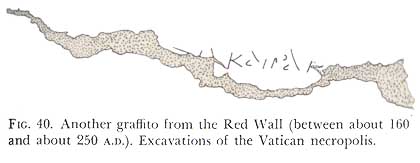 This
brings us to a time not very distant from that in which Gaius, replying
to the heretic Proclus, invited him to come to Rome and promised to show
him the "trophies" of Peter and Paul respectively in the Vatican and on
the Via Ostiense. I have already explained why the "trophies" mentioned
by Gaius must be identified with the tombs of the Apostles.18
Now our graffito, speaking of Peter's tomb in this area, gives full confirmation
to this interpretation.
This
brings us to a time not very distant from that in which Gaius, replying
to the heretic Proclus, invited him to come to Rome and promised to show
him the "trophies" of Peter and Paul respectively in the Vatican and on
the Via Ostiense. I have already explained why the "trophies" mentioned
by Gaius must be identified with the tombs of the Apostles.18
Now our graffito, speaking of Peter's tomb in this area, gives full confirmation
to this interpretation.
The other graffito on the Red Wall (Fig. 40), has stayed in place. It is also written in Greek letters and consists in a single line mutilated at the beginning and the end:
 Among
the letters still legible, we can make out the group KAIP followed by
an apostrophe. This is evidently the imperative singular of the verb
Among
the letters still legible, we can make out the group KAIP followed by
an apostrophe. This is evidently the imperative singular of the verb ![]() ,
(Chairein) written, as it was sometimes during the Imperial era, with
a K instead of a X. Its meaning is equivalent to the Latin "salve," the
English "hail." We cannot say with certainty who is the object of this
greeting; but considering the place where it is found it seems probable
that it was directed at the Chief of the Apostles.
,
(Chairein) written, as it was sometimes during the Imperial era, with
a K instead of a X. Its meaning is equivalent to the Latin "salve," the
English "hail." We cannot say with certainty who is the object of this
greeting; but considering the place where it is found it seems probable
that it was directed at the Chief of the Apostles.
Discussing the Memorial of Peter, I have already mentioned that Tomb R is behind the Red Wall, on the other side of the clivus, and that it can be dated between 130 and 150.19 The graffiti which interest us here are inscribed on the pretty brick surface which covers the eastern side of the tomb. If we look closely we are immediately impressed by the fact that the wall was a favorite surface for inscriptions for a long time. Considering that it faces the clivus behind the Red Wall, one is inclined to think that passers-by must have liked to linger at this spot.
Some of the graffiti seem to be meaningless, carved - one would conjecture - to pass the time: rows of vertical lines, little geometric figures and so forth. But there are others with a very precise meaning. Among the latter there is a Greek graffito on three lines (Fig. 41):
![]()
![]()
![]()
Emnesthe
L. Pakkios
Eutychos
Glykonos
that is, "Lucius Paccius Eutychus remembers Glycon." This very brief phrase had already been read by the first excavators and duly reported, but no special importance had ever been found in it. But it does have considerable significance in the study of ancient devotion to St. Peter in the Vatican.
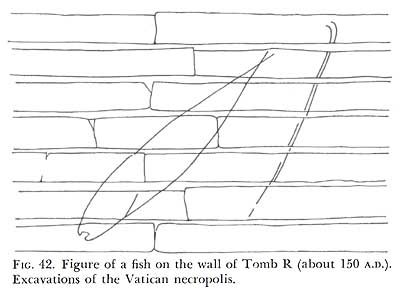 The
name
The
name ![]() is simply a transliteration into Greek of the Latin family name Paccius.
The family of the Paccii seems to have originated in Campania, but many
members are found later in Rome and elsewhere; so it is not necessary
to believe that our Lucius Paccius Eutychus was a native of Southern Italy.
It seems rather (as indicated by his cognomen, Eutychus, borrowed from
the Greek) that he was a freedman, given his liberty by an owner who belonged
to the gens Paccia.
is simply a transliteration into Greek of the Latin family name Paccius.
The family of the Paccii seems to have originated in Campania, but many
members are found later in Rome and elsewhere; so it is not necessary
to believe that our Lucius Paccius Eutychus was a native of Southern Italy.
It seems rather (as indicated by his cognomen, Eutychus, borrowed from
the Greek) that he was a freedman, given his liberty by an owner who belonged
to the gens Paccia.
Lucius Paccius Eutychus is a completely unknown person; and the Glycon mentioned by him is equally obscure: perhaps another freedman or even a slave. But the formula of the inscription is well known and very meaningful: "so-and-so remembered so-and-so." This is one of those texts which scholars refer to with the Latin term tituli memorials, that is, inscriptions intended to record the names of distant friends in places of special interest. This interest could be based on popular devotion, a fame for natural beauty or any other characteristic that would attract visitors. Sometimes the importance of a certain place would arise from its being the beginning or the end of a difficult journey.
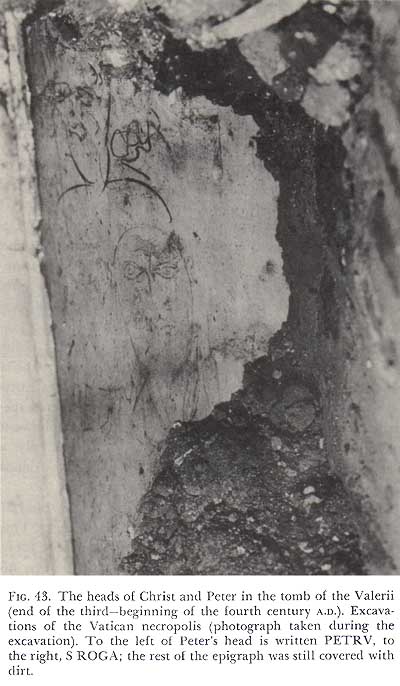 A
very large number of tituli memorials have been preserved from antiquity.
Most of them are pagan, but some Christian ones are also known. Usually
they owe their origin to a religious sentiment and they correspond, in
a way, to prayers. It is not difficult to understand that when a person
prayed at a shrine reached through great effort, or when he looked at
a beautiful, grandiose or unusual spectacle, when he rejoiced at having
escaped a danger or worried before facing one, his thoughts would naturally
turn with affection to his distant loved ones and he would wish to leave
in that place a tangible record of those who had been in his mind: a record
linking his own name with those of the absent ones. This ancient custom
still remains, under somewhat different forms, in our own time. How many
of the faithful, when they go on a pilgrimage to a holy place, write their
own names and those of their loved ones on the stones, the walls or any
other available surface! And we all know that in some often-visited churches
there are convenient cards with an already-printed formula to which only
the names of the persons need be added: "In the - Church - prayed for
--."
A
very large number of tituli memorials have been preserved from antiquity.
Most of them are pagan, but some Christian ones are also known. Usually
they owe their origin to a religious sentiment and they correspond, in
a way, to prayers. It is not difficult to understand that when a person
prayed at a shrine reached through great effort, or when he looked at
a beautiful, grandiose or unusual spectacle, when he rejoiced at having
escaped a danger or worried before facing one, his thoughts would naturally
turn with affection to his distant loved ones and he would wish to leave
in that place a tangible record of those who had been in his mind: a record
linking his own name with those of the absent ones. This ancient custom
still remains, under somewhat different forms, in our own time. How many
of the faithful, when they go on a pilgrimage to a holy place, write their
own names and those of their loved ones on the stones, the walls or any
other available surface! And we all know that in some often-visited churches
there are convenient cards with an already-printed formula to which only
the names of the persons need be added: "In the - Church - prayed for
--."
Scholars who have studied the ancient tituli memorials divide them into two classes, "Occidental and Oriental," according to whether they belong to the western or eastern parts of the ancient world. Inscriptions of the first category have the verb expressing memory in the indicative; those of the second have it in the conjunctive and sometimes express slightly different meanings. The Vatican graffito, with its verb in the indicative, presents the classic formula of "Occidental" type and it is one of the very rare examples found so far in Italy. Examples of the "occidental" style are abundant in Greece and Egypt, but in Italy the only other ones found - up to the present - are a pair from Ponpeii and perhaps, one at Naples.
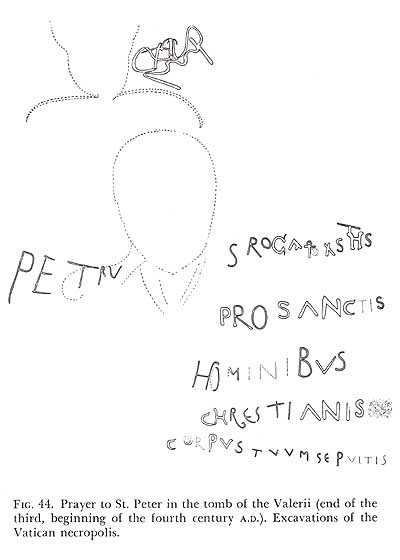 A
comparison with all the other known examples of the "Occidental" formula
shows with absolute certitude that the place in the Vatican necropolis,
where Lucius Paccius Eutychus wished to record his friend's name, was
considered specially important. It was certainly a place where people
went to see something particularly beautiful, unusual or holy, a place
where prayers were offered and where distant friends were remembered in
prayer.
A
comparison with all the other known examples of the "Occidental" formula
shows with absolute certitude that the place in the Vatican necropolis,
where Lucius Paccius Eutychus wished to record his friend's name, was
considered specially important. It was certainly a place where people
went to see something particularly beautiful, unusual or holy, a place
where prayers were offered and where distant friends were remembered in
prayer.
Was Lucius Paccius Eutychus a pagan or a Christian? If he was a pagan, the inscription would have no meaning. This section of the Vatican necropolis had no attraction for a pagan; there was no famous shrine, no natural beauty, no "curiosity" worth seeing. But if we consider the graffito Christian, everything is easily explained; it is sufficient to mention that Peter's Memorial is only a few steps away.
The Christian origin of the graffito is very clearly confirmed by a detail of the same wall: the sketchy but unmistakable outline of a fish (Fig. 42), a symbol specially loved by the faithful who identified it with the Redeemer or with his followers, since each Christian is miraculously "fished" by the Divine Fisherman and reborn in the waters of Baptism.
The graffito of Lucius Paccius Eutychus is Christian, then, and it can only be interpreted in relation to the cult of St. Peter. It is important, therefore, to date it as precisely as possible.
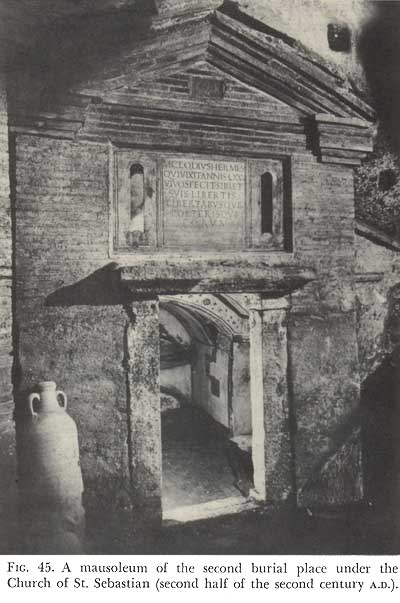 Tomb
R, on whose wall the graffito is carved, is earlier than the middle of
the second century (about 130-150 A.D.), and the graffito seems to be
almost equally old. Several elements testify to its antiquity; the epigraphic
printing; the use of the Greek language which, as I have mentioned, is
that of the earliest Christian inscriptions in Rome; the very name, Lucius
Paccius Eutychus, which presents the so-called tria nomina (first name,
family name and cognomen). It is known that in the names of freedmen,
such as the writer of this graffito certainly was, the tria nomina tend
to disappear at about the end of the second century.
Tomb
R, on whose wall the graffito is carved, is earlier than the middle of
the second century (about 130-150 A.D.), and the graffito seems to be
almost equally old. Several elements testify to its antiquity; the epigraphic
printing; the use of the Greek language which, as I have mentioned, is
that of the earliest Christian inscriptions in Rome; the very name, Lucius
Paccius Eutychus, which presents the so-called tria nomina (first name,
family name and cognomen). It is known that in the names of freedmen,
such as the writer of this graffito certainly was, the tria nomina tend
to disappear at about the end of the second century.
Everything concurs, then, to lead us to the belief that the graffito on Tomb R was written during the second century. And from this fact a very attractive hypothesis rises spontaneously. I have already explained20 that the Red Wall cut off access from the south to the open area, Field P, which is faced by the Apostolic Memorial. From that time on, the place sacred to Peter could not be reached directly by walking past Tomb R. It is reasonable to assume that our graffito was carved during the period when the faithful still passed that way to reach Field P. Therefore the graffito would be, like the wall on which it is carved, earlier than the construction of the Red Wall. Since the Red Wall can be dated certainly around 160, it is possible to place the graffito at least as far back as approximately 150 A.D.
So we can state that at that time, not more than eighty years after the Apostle's death, pilgrims were already coming to the slopes of the Vatican Hill to do honor to the Martyr's Tomb. Eutychus was one of them: the first known to us of the countless pilgrims who have come, through the centuries, to visit the most sacred place in Rome.
D. The Christian Evidence in the Tomb of the Valerii
The tomb of the Valerii is one of the "mausolea" belonging to the necropolis discovered under the Vatican basilica. About twenty meters distant from the Apostolic Memorial, it can be dated between the reign of Marcus Aurelius (161-180 A.D.) and the beginning of the reign of Commodus (180-192 A.D.). It is certainly one of the richest and most beautiful structures in the entire necropolis. Its chief ornament is a series of magnificent plaster decorations (already mentioned when we were considering the necropolis in general).21 For their artistic form and their representational content they are worthy of extended study.
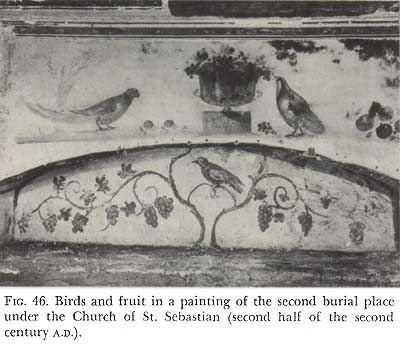 The
large marble plaque imbedded above the entrance informs us that this tomb
belonged to C. Valereius Herma and his family.22 Other inscriptions
found about the edifice refer to members of this family or of related
families. The first bodies to find a resting place within these walls
were pagan, but as the new religion spread Christians were also buried
there. I have already mentioned the sarcophagus of a certain Valerinus
Vasatulus and the tombstone of a joyous Christian soul who, during his
life, always joked and never quarreled.23
The
large marble plaque imbedded above the entrance informs us that this tomb
belonged to C. Valereius Herma and his family.22 Other inscriptions
found about the edifice refer to members of this family or of related
families. The first bodies to find a resting place within these walls
were pagan, but as the new religion spread Christians were also buried
there. I have already mentioned the sarcophagus of a certain Valerinus
Vasatulus and the tombstone of a joyous Christian soul who, during his
life, always joked and never quarreled.23
But the most noteworthy Christian evidence in the tomb of the Valerii is a series of inscriptions traced in red, done over in black. With the inscriptions there are two naïve portraits, one above the other; Christ above, St. Peter below (Fig. 43). The evidence which I mentioned is on the wall facing the entrance, in a niche which held the place of honor and in ancient times contained an elegant plaster figure of Apollo-Harpocrates. Most of the plaster has now fallen away, but the figure of this youthful god (a blending of the Greek Apollo with the Egyptian Harpocrates) can still be seen in outline. The pose is typical; he holds the index finger of his right hand up to his lips as though to silence visitors to this city of the dead, and in his left hand he has a bird.
Next to the right leg of this figure, on the left-hand side of the niche, ist the Christian inscription. In the spring of 1952, when I saw it and, after reading, wished others to see it, the lines of red lead and black carbon were still quite visible. Ten years earlier, when first discovered, they must have been even fresher; but the decay commonly found in ancient pictures was accelerated in this case by the dampness of the place so that today the inscription has almost vanished.
Peter's head in the picture is that of an old bald man with a long beard. In the early Christian centuries the Apostle was generally depicted with a thick head of hair but there is also evidence of a tradition according to which he was bald. To the left of the head are the letters PETRV, and to the right the rest of the epigraph which is distributed through five lines (Fig. 44):
PETRVS
ROGA XS HIS
PRO SANC(TI)S
HOM(INI)BVS
CHRESTIANIS AD
CO(R)PVS TVVM SEP (VLTIS)
"Peter pray for the pious Christian men buried near your body." At the end of the first line are abbreviated signs of Christ Jesus (XS IHS) accompanied by the sign of the crux ansata, an Egyptian symbol of salvation. The adjective sanctis is worthy of note; it does not mean the same as the modern word "saints," but rather all faithful members of the Church in general. Also worth mentioning is the form Chrestianis, rather than Christianis. But the most important fact is the existence in this place of a prayer to Peter as patron of the deceased, a prayer in which, besides, the nearness of the Martyr's tomb is mentioned.
The
head of Peter is surmounted by a very unusual head of Christ. There are
many things that could be said about this figure. Here it will be sufficient
to recall that it bears the word VIBVS ("living") written on
the forehead and is accompanied by the symbol of the Phoenix. This was
a legendary bird which, according to the pagans, burned itself to rise
again from its own ashes; a quality which led the Christians to adopt
the Phoenix as a symbol of resurrection. We should not be surprised, then,
to see the symbol of the Phoenix and the epithet VIBVS applied to Christ,
considered as Life and Resurrection. We might also note that the proximity
of Christ and Peter harmonizes fully with the graffiti on Wall G and other
early Christian inscriptions which show us the Redeemer's name associated
with that of His first vicar.
The very presence of this inscription in the tomb of the Valerii informs us that a certain number of Christians were buried there. It is very probable that the presence of several Christians graves in this tomb led the survivors to direct this simple and trusting prayer to the Apostle. These graves might be identified with the many places for inhumation which, as I have already said,24 were brought to light in the tomb of the Valerii by the most recent excavations. As for the age of the design on the wall, which seems to have been done at various times by various hands, not all at once by a single person, everything leads to the opinion that it can be dated, like the inscriptions on Wall G, between the end of the third and the beginning of the fourth century. In any case, it is previous to the covering over of the burial place and therefore confirms, once again, the fact that Peter was venerated in the Vatican even before Constantine had his great basilica built there.